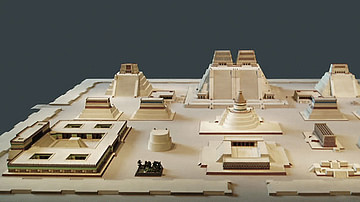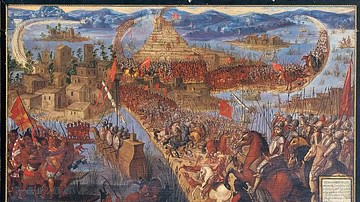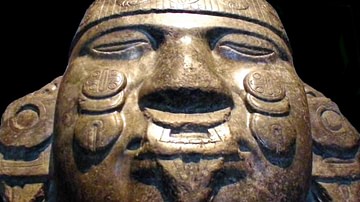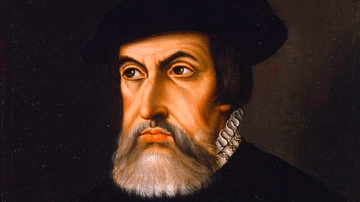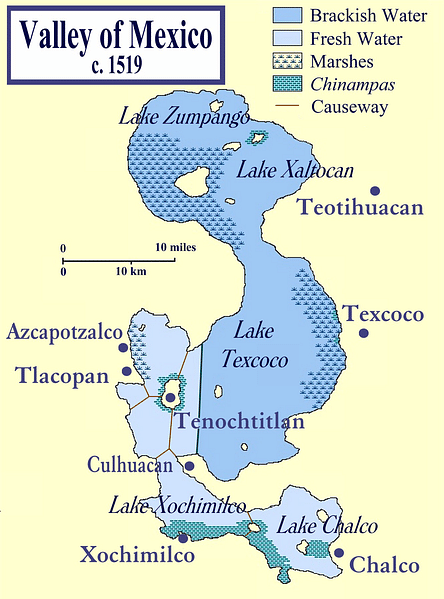
Texcoco (aka Tezcoco or Tetzcoco), located near the eastern shores of Lake Texcoco in the Valley of Mexico, was the capital of the Acolhua people. It was a major power in the Aztec period and a member of the Triple Alliance along with Tenochtitlan and Tlacopan. Texcoco also produced one of Mesoamerica's most famous rulers, Netzahualcoyotl, who presided over a city which became a noted centre of culture and learning.
Early History
Probably settled earlier, it was not until some time in the 13th century CE that significant settlements sprang up on the eastern shores of Lake Texcoco. In semi-legendary local tradition various migrating tribes - the Chichimecs, Tepanecs, Mexica and Acolhua - arrived in the Valley of Mexico at this time and the latter group, led by their chief, Xolotl, headed for the land north-west of the lake and established themselves at Tenayuca. It was Xolotl's son Nopaltzin who was credited with mounting a reconnaissance expedition from Tenayuca and discovering the area around Mt. Tlaloc as a possible place to establish a new city. First the rock caves in the surrounding foothills were inhabited and then, eventually, great settlements would develop to become the cities of Oxtoticpac, Tzinaccanoztoc, Coatlinchan and Huexotla.
Tradition states that Nopaltzin's son Tlohtzin became ruler over the entire eastern area and founded a new centre at the Hill of Tetzcotzingo but, one generation later, his son Quinatzin moved the Acolhua capital to Texcoco which was closer to the lake and so better placed for trade. At this time economic power came to be concentrated into the hands of a small elite who also established trade and cultural links with the neighbouring Chichimecs. A feature of this elite dominance was the creation of special hunting areas around Mt. Tlaloc which were supplied with game by the local communities and given as tribute. Farming also became more sophisticated with the construction of canals for irrigation, terracing, and the 'sunken' gardens or chinampa which became a feature of Mesoamerican agriculture. These developments were traditionally ascribed to Tlohtzin whose father Nopaltzin had married a woman from Chalco (in the south) and so being brought up amongst these sophisticated farmers, Tlohtzin was able to pass this knowledge to the Acolhua. With an agricultural surplus, trade and prosperity became assured for the state of Acolhuacan and its capital Texcoco.
The Rise of Netzahualcoyotl
The Mexica and their allies the Tepanec based at Atzcapotzalco (who were in fact the region's dominant force) were also prospering and, seeking to expand their territory further, they cast covetous eyes at Texcoco. The premise for the Mexica invasion of Acolhuacan was that the leader at Texcoco, one Ixtlilxochitl, who was a descendant of Xolotl and Nopaltzin, following his marriage to a princess of Tenochtitlan, declared himself as the new ruler of the Chichimecs. In 1418 CE Texcoco was conquered and Ixtlilxochitl was defeated and killed but his son Netzahualcoyotl (also spelt Nezaualcoyotl or Nezahualcoatl) survived him. Fleeing to Huexotzingo in the Valley of Puebla he would return in 1422 CE to Tenochtitlan to hone his warrior skills and eventually he returned to his ancestral home at Texcoco. However, seeing his potential as a threat to the status quo, a delegation was sent from Atzcapotzalco to assassinate the young ruler. The plot was uncovered but Netzahualcoyotl was once more forced to find refuge back at Huexotzingo. Netzahualcoyotl's fortunes changed for the better following the death of Chimalpopoca of Tenochtitlan and the rise of Itzcoatl (Netzahualcoyotl's uncle) as leader of the Mexica. An alliance between Tenochtitlan and Texcoco was offered and Netzahualcoyotl was on the road to greatness. He returned to Texcoco and began a war against Atzcapotzalco and the Tepanecs. Atzcapotzalco fell and the Tepenec king Maxtla was brought before Netzahualcoyotl who himself sacrificed his fallen enemy by ripping out his heart, an action performed with great ceremony before all the victorious warriors and nobles.
The Triple Alliance & Expansion
Texcoco now formed the Triple Alliance along with Tenochtitlan and Tlacopan. Texcoco, the second power of the trio, would control the eastern basin of the Valley whilst Tlacopan took the western area and Tenochtitlan ruled the north and south. Tribute taken from conquered states would be shared in a ratio of 2:2:1 between Tenochtitlan, Texcoco, and Tlacopan respectively, and included huge quantities of cloth, food, feathers and rubber. The foundations for the Aztec empire, the last great Mesoamerican one, were now set.
Netzahualcoyotl officially became tlatoani or leader of Texcoco in 1431 CE and he now ruled a city with a population of around 45,000 and controlled a host of lesser cities dotted along the eastern side of the lake. Netzahualcoyotl was also known as something of a student of philosophy, literature and astronomy and was a celebrated poet.
Under the reign of Netzahualcoyotl Texcoco became a noted centre for learning and culture, indeed, of the four great councils of government, one was specifically dedicated to the promotion of science and the arts. The city of Texcoco, then, revolved around the king's great palace which covered over one square mile. As well as the usual pyramids, gardens, fountains, exotic animals and sumptuous apartments there were also dedicated quarters for historians and poets and even a library. The king also constructed a great temple to Tloque Nahuaque, 'the unknown god, creator of all things' which had nine stories symbolising the nine heavens. The top tenth floor was painted black and adorned with stars whilst the interior was sumptuously decorated in gold, gems and exotic feathers.
Texcoco also expanded and consolidated Acolhua control of the region and further developed the irrigation of hillside terraces, constructed a series of impressive aqueducts and laid out magnificent gardens, especially at Tetzcotzinco. Netzahualcoyotl even captured Tollantzinco as part of an evermore ambitious programme of imperial expansion which extracted tribute such as food and wood from the conquered cities. The Triple Alliance would also become more and more ambitious and attacked such states as Tlaxcala and Huexotzingo.
Netzahualcoyotl was, though, careful to give defeated rulers a role in the new empire and so avoid future dissension, hence many were made semi-autonomous district leaders. He is also credited with creating a legal code where 80 laws defined acceptable behaviour and outlined punishments for any offences, even those made by corrupt judges. Crimes covered by the laws ranged from theft to drunkenness and punishments from having one's head shaved to death by strangulation. In addition, the rigidity of the system was mitigated with the flexibility of the more traditional approach of assessing certain cases on their own merit and with a court of appeal consisting of twelve judges.
Netzahualcoyotl was deified after death and his body enshrined at the sacred site of Tetzcotzingo. The Triple Alliance continued, though, even when its founders had passed on the reigns of power to others such as Motecuhzoma II at Tenochtitlan and Netzahualcoyotl's son Netzahualpilli at Texcoco. In demonstration of the close ties between these allies Netzahualpilli participated in the coronation ceremony of the great Aztec king Motecuhzoma II in 1503 CE. Indeed, both Netzahualpilli and Totoquilhuaztli, the leader of Tlacopan, placed the gold and emerald crown on Motecuhzoma's head. In turn, the new king gave the regalia of office to his allied rulers and thus indicated that it was he and his city of Tenochtitlan that led the Triple Alliance.
The Spanish Conquest
However, the Alliance began to show signs of strain, especially following Motecuhzoma's perceived arrogance and his policy of diminishing the role and power of his two allies. Relations had never been quite the same since Netzahualpilli had ordered the death of one of his wives, as she happened to be the daughter of the Aztec king Axayacatl. More significantly, the Texcocans became ever more disaffected with the dominance of Tenochtitlan in the Alliance and this would even lead to Texcoco siding with the Spanish invaders and the election of a new chief, Ixtlilxochitl, with the support of Cortés himself. In 1521 CE Texcoco provided ships and men to aide the Spanish siege of Tenochtitlan which would bring about the downfall of the entire Aztec empire.
Few physical remains survive of Texcoco, now buried under the modern city of the same name. Some stone reservoirs, the aqueduct, steps and terraces survive from the irrigation systems of the magnificent gardens at Tetzcotzinco, a few illustrations from the various Codexes and some poems of Netzahualcoyotl also survive. This small legacy for such a great city and the general impermanence of life is, in fact, a much repeated theme in Aztec culture in general and elegantly described in the following poem attributed to the greatest ruler of Texcoco:
I, Netzahualcoyotl, ask this:
Is it true one really lives on the earth?
Not forever on earth,
only a little while here.
Though it be jade it falls apart,
though it be gold it wears away,
though it be quetzal plumage it is torn asunder.
Not forever on earth,
only a little while here.
(Miller, 238)



